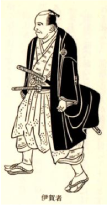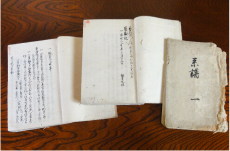- Home
- What is Ninja Study
The Medieval Ninja
Today in the modern era, the term, “ninja” is often used to refer what was historically called “shinobi”. The main objective of the shinobi was that of gathering intelligence and information for the lords they served. It is believed that they originated from the akuto (悪党 which can be roughly translated as “The evil bands”). The akuto gradually gained the military influence since the end of Kamakura period (1185-1333). The activity of the shinobi can be verified from the 14th century (Nanbokucho period in Japan) to the second half of the 19th century (the end of Edo period in Japan). As in the Iga province the power of feudal lords (daimyo) was comparatively weak, so the local warriors took the burden of self-governing functions and developed the methods of ninjutsu to defend themselves. Thus, during the first Tensho Iga no Ran of 1579 (Tenshō Iga War) they defeated the troops of the warlord, Oda Nobunaga (1534─1582).

The Ninja of the Pre-modern period
In the Pre-modern period, when the feudal wars ended, the ninja were employed both by the shogunate and by the domains all over Japan, receiving the status of low rank samurai, the peasants with some samurai privileges, or just usual peasants.
The Iga-mono (literally “People from Iga”) on the service of the shogunate often considered the Ninja fom Iga as their ancestors. According to some sources, sometimes they still were recruited for the secret missions of information gathering.
Particularly, the documents from Matsushita family archive can shed some light on the details of service of the shogun’s Iga-mono.(For further details see the book “The Ninja descendants” by Takao Yoshiki (高尾善希『忍者の末裔』角川書店 in Japanese only).
Those Ninja who were employed by the local domains were also employed to obtain the information about neighboring domains, peasant revolts and so on. Either way, they were still implemented for spycraft. But in many cases their everyday duties were those of guards in the castle or in the castle town.
At the same time, among those Ninja who stayed in the village, there were also those families who transmitted their knowledge through generations by means of writing Ninjutsu manuals.(Takao Yoshiki)
Ninjutsu Manuals
The ancient books dedicated to the art of Ninjutsu are what we call “Ninjutsu Manuals” (ninjutsu-sho 忍術書 in Japanese). The subjects discussed in the manuals are extremely versatile. They range from the attitude of the shinobi toward their duties to the discussion of the details of their skills. These skills include infiltration, disguise, interaction with local civilians, eloquent speech, mnemonic, transmission of the information, magic, martial arts and others. Also they list a huge amount of knowledge in various categories such as medicine, pharmacy, food, astronomy, meteorology, producing black powder and so on. For tasks of information gathering the shinobi needed to be proficient in many arts and skills, and that’s why so much versatile knowledge is compiled into ninjutsu manuals. Much of this knowledge and information are lost nowadays, so during our research we are searching ways to revive some of them and find to them a fruitful application in modern society. (Text by Yuji Yamada)

The fictional image of the Ninja
During the peaceful Edo period (1603-1868) the average person usually did not have an opportunity to see a ninja in action. As a result, image of the ninja as shown in popular fiction such as books and theatre became common. Two main patterns of the narratives where a ninja is the main character are as follows: 1) Ninja infiltrates somewhere using the art of ninjutsu, steals a treasure and returns with it. 2) Ninja, who possesses the magical art of ninjutsu, tries to use it to overthrow the government or to take over the patrimony. Nowadays, a ninja is usually portrayed as a figure clad in black and throwing a shuriken. However, from the beginning of the Edo period to the mid-18th century the ninja were portrayed wearing clothes like that of a normal civilian would wear during those times. Since the mid-18th century, theatre plays began to feature the ninja in black outfits and masks while throwing shuriken (which was done to make clear that the character is a ninja). From the beginning of the 19th century the same ninja outfit became common in popular novels as well. In the Edo period the ninja were usually portrayed as evil and villainous individuals, but in the Taisho era (1912─1926) the publishing house “Tatsukawa-bunko”, introduced a rather heroic image of the ninja in the form of the character, Sarutobi Sasuke. This character was the first of its kind in history. (Text by Katsuya Yoshimaru)








